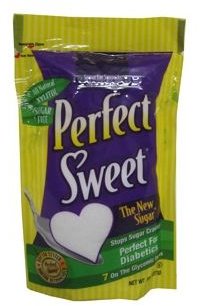Is Xylitol Safe to Eat?
Xylitol is a natural carbohydrate classified as a sugar alcohol. It is found in most plants, including many fruits and vegetables, and occurs naturally in human bodies - the body produces about 5 to 15 grams a day. It was discovered by a German chemist named Emil Fischer in 1891 and has been used as a sweetening agent since the 1960s.
Health Benefits
Xylitol is considered a “sugar-free” sweetener, but differs from artificial sweeteners like aspartame and Splenda® because it is all-natural. It is almost identical in sweetness to table sugar (sucrose), but has 40 percent fewer calories. It also has a lower glycemic index than sucrose (7 compared to 65), meaning it is absorbed more slowly from the intestines into the blood, thus preventing a rapid rise in blood sugar levels. In addition, according to Drugs.com, it does not depend on insulin to be metabolized.
Diabetes
According to The American Journal Clinical Nutrition, xylitol is a suitable component of the diet for diabetic patients. However, Web MD says there is insufficient evidence for xylitol as a sugar substitute for people with diabetes, and according to Maria Collazo-Clavell, M.D., a member of the American Association of Clinical Endocrinologists, the American College of Endocrinology, the American Diabetes Association and The Endocrine Society (Mayo Clinic), diabetics should be cautious with sugar alcohols like xylitol because they can increase blood sugar levels. If you are diabetic, it is best to consult your health care provider before using.
Cavities
In a University of Michigan study involving more than 1,200 children, chewing gum with xylitol dramatically reduced new cavities, and also helped reverse the process of decay in existing cavities. When oral bacteria metabolizes sucrose, it breaks down into acids causing cavities. Xylitol, on the other hand, produces almost no acid because bacteria does not metabolize it efficiently. Web MD says 1 to 20 grams of xylitol, from products such as chewing gum, candies and foods, is needed per day to significantly reduce the rate of cavity formation in children and adults.
Acute Otitis Media
Xylitol may also help in the prevention of ear infections in young children. According to two double-blind studies, the occurrences of infections were reduced by 40 percent in children given xylitol chewing gum (Drugs.com).
Osteoporosis
Dietary xylitol increases calcium absorption in the intestines. When added to calcium supplements and given to rats deficient in calcium, it was shown to accelerate bone repair and improve the bioavailability of calcium salts (Drugs.com).
Safety
Xylitol was approved in 1963 as a dietary sweetener by the U.S. Food and Drug Administration (FDA). It is considered safe in the amounts found in foods. It also appears to be safe for most adults in amounts up to 50 grams per day, and for most children in amounts up to 20 grams per day.
Because sugar alcohols do not fully break down during digestion, diarrhea can occur with high doses.
It is used as a sweetener for diabetics in many countries. However, as mentioned earlier, it is best to talk to your health care provider before using if you have diabetes.
Women who are pregnant or breastfeeding should also consult their health professional before using.
Extremely high doses of xylitol over a long period of time, more than three years, may possibly cause tumors.
Pets
Is xylitol safe for pets to eat? According to Carlye Rose, DVM, DABVP, it can be dangerous to dogs. Unlike humans, xylitol does not absorb slowly in dogs. In fact, it absorbs rapidly and acts as a strong promoter of insulin release, resulting in hypoglycemia. Symptoms include vomiting, loss of coordination and seizures, which may be seen within 30 minutes after ingestion. Doses as low as 0.1 grams per kilograms can cause hypoglycemia, and doses exceeding 0.5 grams per kilograms can put a dog at risk for hepatotoxicity and possibly death.
It is not clear at this time how xylitol affects cats or other pets. However, the American Society for the Prevention of Cruelty to Animals (ASPCA) advises not giving xylitol to any animal.
Cooking with Xylitol
As a sugar substitute, xylitol is equal to table sugar in measurements, although it may slightly vary depending on the recipe. However, you cannot use it in recipes that require yeast to make dough rise because it cannot be metabolized by yeast, and you cannot use it in recipes that require sugar to be caramelized because it does caramelize like table sugar.
References
The American Journal Clinical Nutrition: Metabolic response to lactitol and xylitol in healthy men - https://www.ajcn.org/content/65/4/947.short
Drugs.com: Xylitol - https://www.drugs.com/npp/xylitol.html
WebMD: Xylitol - https://www.webmd.com/vitamins-supplements/ingredientmono-996-XYLITOL.aspx?activeIngredientId=996&activeIngredientName=XYLITOL&source=2
Mayo Clinic: Can I use artificial sweeteners if I have diabetes? - https://www.mayoclinic.com/health/artificial-sweeteners/AN00348
University of Michigan: Gum with xylitol ‘dramatically reduces new cavities’ - https://ur.umich.edu/9293/Mar29_93/15.htm
Carlye Rose, DVM, DABVP: Xylitol Toxicosis - https://www.mem610.com/docs/Xylitol%20Toxicosis%20Information.pdf
Photo by Health Guy / Flickr
